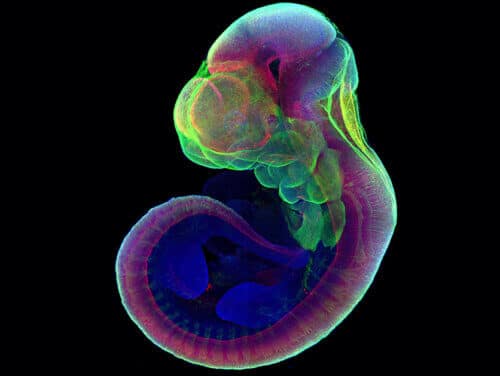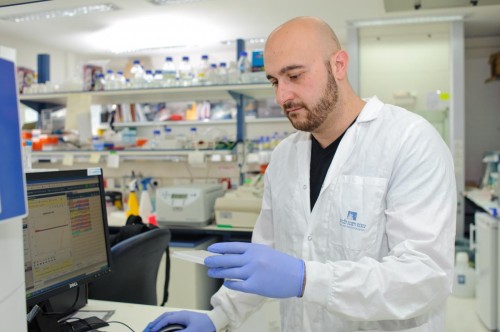The new method they developed is expected to be an unprecedented tool in the study of the embryonic development of mammals

To watch new life form before our eyes - scientists in the field of developmental biology have been trying to achieve this feat for a hundred years. Using a new method they developed, the scientists of the Weizmann Institute of Science were able to grow mouse embryos outside the womb from the very initial stages of pregnancy - right after the fertilized egg is fixed in the wall of the uterus - up to the advanced stages of the formation of the organs in the embryo. This new method whose findings are published today in the scientific journal Nature, is expected to be an unprecedented tool in the study of fetal development and may provide new insights into congenital and developmental defects and various fertility problems.
Prof. Yaakov Hana from the department of molecular genetics at the institute, explains that much of what we know today about embryonic development originates in one of two ways: observing the embryonic development of non-mammals - for example fish or amphibians - or a fragmented and partial picture of the embryonic development of mice at different stages of pregnancy. The reason for this is that unlike the embryonic development of fish or frogs which takes place outside the body inside transparent eggs, the uterus in mammals is a kind of "black box" that does not allow direct and continuous observation of the development of life. Despite repeated attempts since the XNUMXs, to grow embryos outside the womb from the initial stages of development to advanced stages, these attempts had only limited success, and the developed embryos tended to be abnormal.

For seven years, through trial and error, fine-tuning and repeated tests, Prof. Hana's laboratory, which specializes in embryonic stem cells, developed a two-stage method that allows growing normal mouse embryos outside the womb from the initial stages of pregnancy - from the stage when the embryos are nothing more than a lump uniform of identical cells up to the stage where they have a well-defined body and internal organs. "These stages are the most mysterious and interesting part of embryonic development. Now, using the new method, we can observe these stages in detail and perform various experiments that were not possible before," says Prof. Hana.
In the first phase, the research team led by Alejandro Aguilera, Dr. Bernardo Oldak, the late Dr. Rada Masarva, Dr. Noa Noverstern and Dr. Itai Maza, a former research student in Prof. Hana's laboratory and currently a medical researcher at the Rambam Center, raised embryos A few days old - in the developmental stage where they are like balls consisting of 250 identical stem cells. The scientists were able to make these balls take root in a special growth medium inside a laboratory vessel - similar to how they take root in the wall of the uterus. In doing so, they were able to mimic the first stage of embryonic development, during which the embryo multiplies in size, while differentiating into three layers of cells: inner, middle and outer.
After about two days - when the embryos entered the next stage where the various organs develop - they were transferred to a nutrient solution in tiny laboratory beakers placed on wheels. In the absence of blood flow from the mother to the placenta, the movement of the wheels allowed for constant mixing of the nutrients in the solution surrounding the embryos. In addition, the researchers made sure to monitor and regulate the amount and pressure of the oxygen and carbon dioxide in the laboratory vessels.
To check whether the processes of development outside the womb were normal, the team made careful comparisons of the embryos that developed outside the womb with embryos that developed in the womb at different time points. The researchers discovered that the developmental processes were exactly the same in both groups. Later, the researchers were able to mark the developing organs in embryos outside the womb using fluorescent genes. Your success with this bodes well for future research possibilities. "We believe that it is possible to inject genes or other elements into embryos that develop using this extrauterine method, and get results that are consistent with what happens in the womb," explains Prof. Hana.
"If the embryo is given the conditions it needs, the genetic code comes into action and knocks down one brick after another in the domino chain of life's development," he adds. "Our goal was to succeed in reproducing these conditions, so that we could observe in real time the domino effect in action." Prof. Hana also explains that this method is expected, among other things, to reduce the use of laboratory animals, lower costs and speed up research processes in the field of developmental biology.
In follow-up studies, in Prof. Hana's laboratory, they will try to grow the embryos outside the womb already from stage zero and to produce artificial embryos from stem cells for this purpose. They will also try to harness the method they developed to check why so many pregnancies are not absorbed, how stem cells gradually lose their character as the differentiation process progresses and what conditions during pregnancy may lead to developmental disorders.
Also participating in the study were Tom Shani, Shadi Tarzi, Jonathan Beyrel, Valeria Chugeeva, Dr. Monif Ayash, Shahed Ashiohi, Daoud Shiban, Nir Livnat, Dr. Lior Lassman, Sergi Vyukov and Miri Zarbiv from the Department of Molecular Genetics at the Institute ; Dr. Yonatan Shtelzer, Dr. Yoah Reis and Dr. Saifeng Cheng from the department of molecular cell biology at the institute; Dr. Yosef Addi and Dr. Hadas Keren-Shaul from the Department of Life Sciences Research Infrastructures at the Institute; Dr. Nadir Ganem and Chen Itzkovits from the Rambam Medical Center; Dr. Sharon Slomovich from the Technion, and Ra'an Shlomo from Arad Technologies.
More of the topic in Hayadan:
- The father of the "test tube babies", Prof. Robert Edwards from Great Britain won the Nobel Prize for Medicine
- Dr. Yaakov Hana from the Weizmann Institute, one of the Krill Prize winners: The prizes give me energy to continue research
- A method for increasing the production efficiency of the stem cells
- For the first time: completely "neutral" human stem cells, which developed into tissues inside a mouse embryo
- A new method for increasing the production efficiency of stem cells
